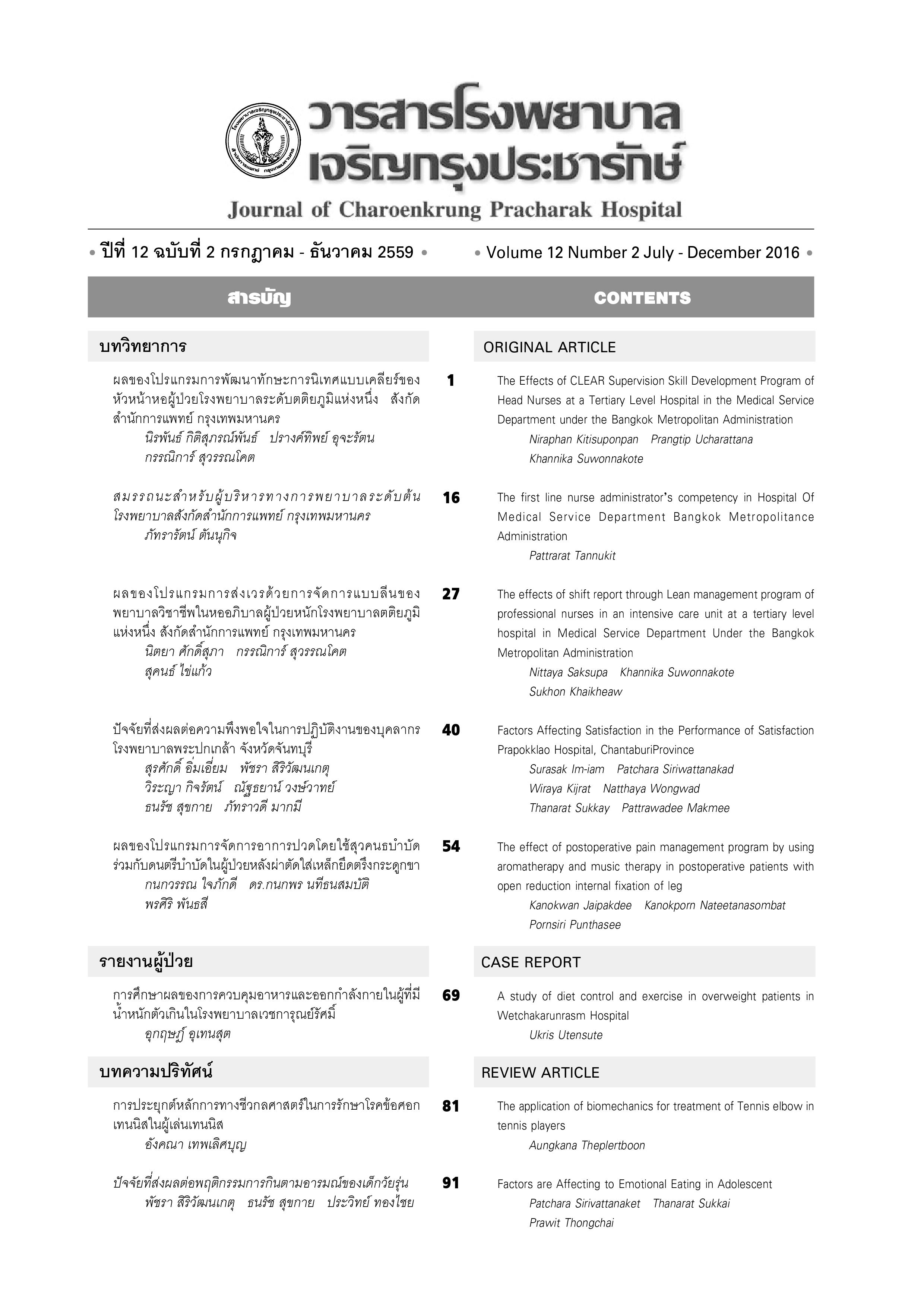การศึกษาผลของการควบคุมอาหารและออกกำลังกาย ในผู้ที่มีน้ำหนักตัวเกินในโรงพยาบาลเวชการุณย์รัศมิ์
Main Article Content
บทคัดย่อ
จุดประสงค์: ศึกษาถึงผลของการควบคุมอาหารร่วมกับออกกำลังกายในผู้ที่มีน้ำหนักตัวเกินและนำผลสำเร็จ จากการศึกษามาใช้เป็นแนวทางในการรักษาผู้ป่วยที่มีน้ำหนักตัวเกินที่มารักษาที่โรงพยาบาลเวชการุณย์รัศมิ์
รูปแบบวิธีวิจัย: การศึกษานี้เป็นการศึกษาเชิงวิเคราะห์แบบไปข้างหน้า (Prospective cohort studies) ที่เป็น กรณีศึกษาของผู้ป่วยที่มีน้ำหนัก ตัวเกินจำนวน 8 รายเป็นชาย 5 รายหญิง 3 รายมีน้ำหนักตัวเฉลี่ย 100.00 กิโลกรัม และมีดัชนีมวลกายเฉลี่ย 38.50 กก./ตร.ม. ทั้งหมดเป็นอาสาสมัครที่จะได้รับการจำกัดอาหารไม่เกิน วันละ 1,000 kcal ร่วมกับการ ออกกำลังกายประมาณ 90-225 นาทีต่อสัปดาห์ โดยอาสาสมัครทั้ง 8 ราย ยินยอมที่จะนอนโรงพยาบาล ในช่วงเดือนเมษายน พ.ศ. 2557 ถึงกันยายน พ.ศ. 2558 เป็นระยะเวลาคนละ ไม่น้อยกว่า 2 สัปดาห์ เพื่อให้การจำกัด อาหารและออกกำลังกายสามารถทำได้อย่างต่อเนื่องใกล้เคียงกับเกณฑ์ที่กำหนดมากที่สุดและติดตามต่อเนื่องอีกเฉลี่ย เป็นระยะเวลา 3 เดือน
ผลลัพธ์: อาสาสมัครทั้ง 8 รายนอนโรงพยาบาลเฉลี่ย 22.75 วัน (SD= 9.19) โดยทั้ง 8 รายมีน้ำหนักตัวลดลง เฉลี่ย 9.54 กิโลกรัม (9.85 %, p value = 0.000) ในวันที่ออกจากโรงพยาบาล คิดเป็นน้ำหนักตัวลดลง เฉลี่ย 2.93 กิโลกรัมต่อสัปดาห์ ผู้ป่วย 6 รายจาก 8 รายเป็นเบาหวานซึ่งมีระดับ HbA1C เฉลี่ย 8.42 % และเมื่อนัดติดตามผล ที่ระยะเวลา 3 เดือนพบว่าค่า HbA1C เฉลี่ยอยู่ที่ 6.57 % ซึ่งลดลง 1.85 % (p value =0.008) ไม่พบความแตกต่าง อย่างมีนัยสำคัญทางสถิติของค่า mAP, HDL-cholesterol และ LDL-cholesterol
สรุปผล: การควบคุมอาหารและการออกกำลังกายสามารถลดน้ำหนักในผู้ที่มีน้ำหนักตัวเกินได้อย่างมี ประสิทธิภาพรวมทั้งยังสามารถลดระดับน้ำตาลในเลือดของผู้ที่มีเบาหวานร่วมด้วยได้อย่างมีประสิทธิภาพ
คำสำคัญ: อ้วน น้ำหนักเกิน อาหารแคลอรี่ต่ำ
Article Details
เอกสารอ้างอิง
2. Aekplakorn W, Mo-Suwan L. Prevalence of obesity in Thailand. Obes Rev. 2009; 10: 589-92.
3. Aekplakorn W, Hogan MC, Chongsuvivatwong V, Tatsanavivat P, Chariyalertsak S, Boonthum A, Tiptaradol S, Lim SS. Trends in obesity and associations with education and urban or rural residence in Thailand. Obesity (Silver Spring) 2007; 15: 3113-21.
4. Whitlock G, Lewington S, Sherliker P, Clarke R, Emberson J, Halsey J, et al. Body-mass index and cause-specific mortality in 900 000 adults: collaborative analyses of 57 prospective studies. Lancet 2009;373:1083-96.
5. Cheskin L. (June, 2011) Prescription drugs that can cause weight gain. John Hopkins Health Alert. Accessed November 18, 2012.
6. Drugs.com (March 2012) Prescription Meds Can Put on Unwanted Pounds. Accessed online November 18, 2012.
7. NHLBI Obesity Education Initiative.The Practical Guide : Identification,Evaluation, and Treatment of Overweight and Obesity in Adults [Online]. 2000 [cited 2015 Apr 17]. Available from: http://www.nhlbi.nih.gov/files/docs/guidelines/prctgd_c.pdf
8. Jensen MD, Ryan DH, Apovian CM, et al. Guideline for the Management of Overweight and Obesity in Adults. Journal of the American College of Cardiology 63(25):2985-3023
9. Markovic TP1, Jenkins AB, Campbell LV, Furler SM, Kraegen EW, Chisholm DJ. The determinants of glycemic responses to diet restriction and weight loss in obesity and NIDDM. Diabetes Care. 1998 May;21(5):687-94.
10. Arthur Weltman, Ph.D., Sharleen Matter, Ph.D., R.D., and Bryant A. Stamford, Ph.D. Caloric restriction and/or mild exercise: effects on serum lipids and body composition. The American Journal of Clinical Nutrition 33: May 1980, pp.1002-1009.
11. Weinsier RL, Ullmann DO. Gallstone formation and weight loss. Obes Res.1993; 1(1): 51-6.
12. Wadden T. A., Sternberg J. A., Letizia K. A., Stunkard A. J., Foster GD (1989) Treatment of obesity by very low calorie diet, behavior therapy, and their combination: a five-year perspective. Int J Obes. 13: 39–46.
13. Tsai AG, Wadden TA. The evolution of very-low-calorie diets: an update and meta-analysis. Obesity (Silver Spring). 2006 Aug;14(8):1283-93.


